The Outer Darkness - Revelation 12: The Red Dragon
The book of Revelation: A strange vision given to John of a world racked by geophysical upheaval and spiritual transformation, it is a book cloaked in allegory and metaphor; one that is very difficult to penetrate. Indeed, many people throughout the ages have asked, just what does Revelation mean or what message does it encode? Herein I do offer up a solution to at least one part of the book: Chapter 12.
This is the story of a series of great portents appearing in the sky that herald a time of immense troubles upon the Earth. An experience that man must endure in some future age yet to come. At the beginning of Revelation 12 - parts 1 through to 6, an array of characters are introduced, each with their own special significance to the story.
Just what is the correct solution though to those characters?
Revelation Bible Verses – 12: 1-6. Consider the relevant section of the text in question (King James Bible 1611 version):
Revelation 12
AND there appeared a great wonder in heaven; a woman clothed with the sun, and the moon under her feet, and upon her head a crown of twelve stars:
2 And she being with child cried, travailing in birth, and pained to be delivered.
3 And there appeared another wonder in heaven; and behold a great red dragon, having seven heads and ten horns, and seven crowns upon his heads.
4 And his tail drew the third part of the stars of heaven, and did cast them to the earth: and the dragon stood before the woman which was ready to be delivered, for to devour her child as soon as it was born.
5 And she brought forth a man child, who was to rule all nations with a rod of iron: and her child was caught up unto God, and to his throne.
6 And the woman fled into the wilderness, where she hath a place prepared of God, that they should feed her there a thousand two hundred and threescore days.
The Woman Clothed With The Sun
The first character introduced at the beginning of Revelation 12 is that of a woman clothed with the sun. But just who is the woman?
Some researchers have posited that the woman is representative of the constellation Virgo, wherein there is in effect a conjunction involving both Virgo and the moon. The crown of 12 stars here then is simply thought to refer to the stars of the Virgo constellation itself.
Such a solution does however appear to be grossly in error. Indeed, one does not even need to guess here as to the identity of either the woman or the great red dragon. The answer readily presents itself upon consideration of the esoteric text commonly referred to as the Pistis Sophia, previously introduced in the first essay of my Outer Darkness series. Within the Pistis Sophia, one finds a far more detailed explanation of the very same set of events as given in Revelation 12, wherein the identity of the two portents is revealed with some precision. The critical passage comes from chapter 136 of the Pistis Sophia. Here it is related that Jesus, within the presence of his disciples, stands before an altar to invoke the name of the father of the Treasury of light. Now one may indeed recall from my previous essay on The Outer Darkness that in the Gnostic hierarchy the Treasury of Light is the aeon that souls pass through upon achieving salvation. Moreover, even in the Bible one can find Jesus making reference to this region:
Lay not up for yourselves treasures upon earth, where moth and rust doth corrupt, and where thieves break through and steal. But lay up for yourselves treasures in heaven, where neither moth nor rust doth corrupt, and where thieves do not break through nor steal. For where your treasure is, there will your heart be also.
Matthew 6:19-21 - King James Version (KJV)
In conducting his ritual of invocation, Jesus gives a penetrating insight into some of the higher light realms of existence and their activities, presenting in far greater detail the same scene as would appear to be given in Revelation 12. Consider in full the critical passage:
Pistis Sophia - Chapter 136
Jesus made invocation... speaking the name of the father of the Treasury of the Light, and said: "Let all the mysteries of the rulers and the authorities and the angels and the archangels and all powers and all things of the invisible god Agrammachamarei and Barbēlō draw near the Leech [Bdella] on one side and withdraw to the right."
And in that hour all the heavens went to the west, and all the æons and the sphere and their rulers and all their powers flew together to the west to the left of the disk of the sun and the disk of the moon. And the disk of the sun was a great dragon whose tail was in his mouth and who reached to seven powers of the Left and whom four powers in the form of white horses drew.
And the base of the moon had the type of a ship which a male and a female dragon steered and two white bulls drew. The figure of a babe was on the stern of the moon who guided the dragons who robbed the light from the rulers. And on its prow was a cat's face. And the whole world and the mountains and the seas fled together to the west to the left.
In light of the citation from the Pistis Sophia, it would seem then that the true identity of the first great wonder seen in the heavens in the book of Revelation is none other than the moon. Indeed, although 3 apparently separate components to the portent are noted i.e. the woman, the moon at her feet, and the crown of 12 stars, it would appear that they do not in fact denote three separate entities as such. Rather, they are a ‘complete package’ so to speak; a single entity: the very moon itself as a celestial body. Quite simply, reference is being made to what are three aspects of one object.
Firstly, one should note the simple fact that the moon as a celestial body does not give out its own light but merely reflects the light of the sun. When bathed in the light of the sun, one may readily accept that the moon is clothed with its light. Here then the illuminated part of the moon is the woman of Revelation.
Secondly, the 12 stars that crown the woman are doubtless a simple reference to the 12 calendar months of a year. Moreover, one should consider also that the word crown in English comes from the word corona, which is a word very much associated with an eclipse; an event itself intimately linked to the orbit of the Moon about the Earth.
Thirdly, one has this seemingly odd statement of the woman having the moon ‘at her feet.’ Now the woman (component) herself as already noted is the illuminated part of the moon. What must be at her feet then is a second aspect of this body. This must be the ‘base of the moon’ having the ‘type of a ship’ - as referenced from the Pistis Sophia. In essence, one would suppose the arc pattern closely associated with the dark side of the Moon i.e. that which is not illuminated.
Lastly, one may also note in addition to these points that in the book of Revelation the woman is with child, crying out to be delivered. One can see a clear reference in the Pistis Sophia to a ‘figure of a babe’ being on ‘the stern of the moon.’ This also further establishes the identity of the first great portent as the moon.
Revelation 12 & The Greek Myths
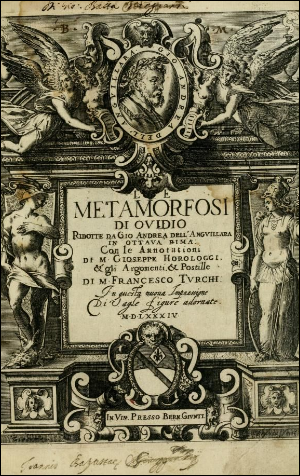
It is not without significance that there is also a close association between the woman of Revelation 12 and a certain Greek myth related by Ovid, the classical Roman poet of antiquity. In his famous work entitled Metamorphoses, Ovid relates the story of how the Sun fell in love with the moon, the latter body being personified in the form of a female deity called Leucothoe. One may be more familiar however with the term Luna. A somewhat shortened variation of this name.
So the story goes… upon meeting Leucothoe to declare his love, the sun finds her attended upon by 12 maidservants, no doubt being a reference to the 12 calendar months in a year. Now after dismissing the maidservants, it is then that the Sun reveals his full light to Leucothoe, whereupon he passionately embraces her. Truly there are many parallels between the story of Revelation 12 and the Greek myth of the sun and Leucothoe.
Indeed, the story concerning these two beings is one that also involves a series of great Earth changes, all triggered by a special conjunction pattern established in the heavens. In effect, it would appear that this story is in fact very much identical to that of the book of Revelation; simply set in a different culture with a different pantheon of deities.
The Great Red Dragon
From both the book of Revelation and the cited passage from the Pistis Sophia, one can see many similarities with respect to the appearance of a Dragon in the heavens. In Revelation 12 this is the second great portent in the sky after the woman clothed with the Sun. Here the Revelation Bible verses state that the Dragon itself has seven heads, with a crown upon each head. The Pistis Sophia states that the Dragon ‘reaches to the seven powers of the left.’
Now it is quite clear from reading the Pistis Sophia that the Dragon is associated with the disk of the Sun. But more than this, the Dragon has its tail in its mouth. This critical reference identifies the Dragon in question as being none other than the Dragon of The Outer Darkness. Indeed, one may cite a further passage from the Pistis Sophia noting an additional connection between the Sun and the outer darkness that is most pertinent to the current discussion:
Pistis Sophia - Chapter 131
Mary continued again and said: "My Lord, doth the dragon of the outer darkness come into this world or doth he not come?"
The Saviour answered and said unto Mary: "When the light of the sun is outside [? above the world], he covereth the darkness of the dragon; but if the sun is below the world, then the darkness of the dragon abideth as veiling of the sun and the breath of the darkness cometh into the world in form of a smoke in the night,- that is, if the sun withdraweth into himself his rays, then indeed the world is not able to endure the darkness of the dragon in its true form; otherwise would it be dissolved and go to ruin withal."
What this particular passage is essentially saying then is that a disruption to the light waves of the Sun causing them to cancel out i.e. go completely 180° out of phase on aggregate balance, allows the Dragon of the outer darkness to manifest in our world. Indeed, one may recall that the symbolism of the Dragon swallowing its tail is indicative of the cancellation of energetic waveform patterns.
Now the importance of this very point helps to explain just why the Dragon - at least in the book of Revelation - is noted as being red in colour. In the visible spectrum there are seven colours. If one goes beyond the final colour at each end of the spectrum, then one will pass into a frequency range which is invisible to the human eyes: Violet to ultraviolet, or red to infrared.
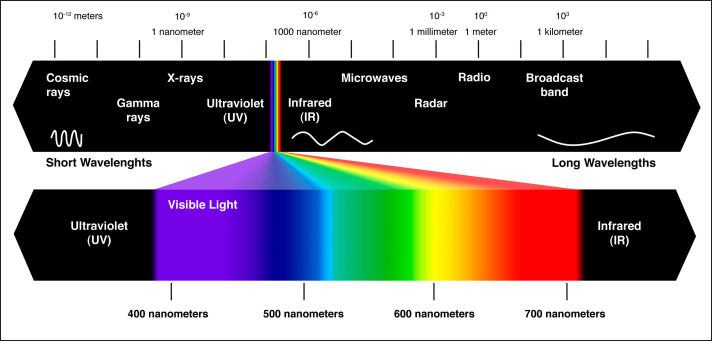
Essentially, what is being described in Revelation 12 is the build-up to a special celestial pattern being established in the heavens. One that has a most exotic energetic effect on the Sun. Namely, a pattern capable of causing the sun's light waves to transform from their normal activity into a radically different configuration, wherein they cancel themselves out. Now this process does not happen instantly, as such. It unfolds in a very precise way. As the regular patterns of the light waves suffer disruption, they naturally cycle through the visible colours of the spectrum.
The final colour achieved by the Sun is red, just prior to passing into infrared. Indeed, this particular passage is concerned with the Revelation prophecy of the days of darkness, as said to occur at the consummation of the age. Specifically then, the great red Dragon is identified as the Sun itself when it is in the final stages of the cancellation of its light waves. Of course one should realise, that this effect is temporary, and sustained only so long as the celestial pattern responsible for triggering it is itself sustained.
Revelation Timeline – Achieving Alignment
Consider the state of the heavens with respect to the Sun, moon, and the Earth, at the beginning of Revelation 12, verse 4. The great red Dragon has just appeared:
And his tail drew the third part of the stars of heaven, and did cast them to the earth.
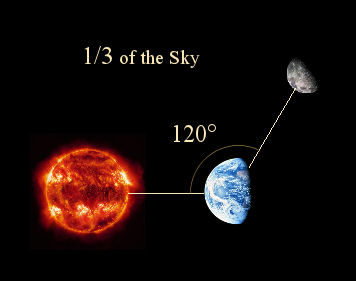
Now this is a most curious statement to be sure, yet it's solution would in fact appear to be rather straightforward. What this precise statement would seem to imply is that the configuration of the celestial bodies of interest is of the following type (image left):
The statement is merely drawing attention to the fact that there is a 120° angular sweep between the line connecting the moon to the Earth, and the line connecting the Sun to the Earth. This is indeed an angular sweep of one third of the sky down to the Earth.
The earth is essentially the ‘centre point’ of the arrangement. The second part of Revelation 12, verse 4, then has the following:
And the dragon stood before the woman which was ready to be delivered, for to devour her child as soon as it was born.
Now in the esoteric realm there are several code words which are often used to imply a conjunction. They are crowning, embracing, and devouring.
As noted previously, the word Crown comes from Corona, which is the Halo about the moon achieved in a solar eclipse – itself a conjunction event. Moreover, one may also note the Greek myth of Phaethon, wherein Phaethon is crowned by his father the Sun (God). This is achieved with respect to the planet Jupiter, who indeed is associated with Zeus, the chief god of the Greek pantheon.
Now the very word Phaethon actually means ‘chariot,’ and is said to be the celestial body that once existed between the planets Mars and Jupiter that was destroyed at some point in remote history, leading to the creation of the asteroid belt. In the story of Phaethon, as related by Ovid in his work Metamorphoses, Zeus (Jupiter) threw a thunderbolt at Phaethon to destroy him at the point of a conjunction between himself, Phaethon and the Sun. From the perspective of Jupiter, Phaethon was crowned by the Sun much like the moon is crowned by the Sun during an eclipse.
In addition to this, there are several instances also in mythology of gods embracing one another, which also implies a conjunction. One example is that already given with the embrace between the Sun and Leucothoe. A further Greek myth recounted in Metamorphoses that is also worthy of note concerns the illicit affair between Aphrodite and Ares. In this particular story, the Sun witnesses a passionate embrace between these two gods. Yet they too are representative of planets. Aphrodite is the goddess of love that represents Venus. Ares is the God of War represented by the planet Mars. When the Sun sees the passionate embrace of the gods, the Sun witnesses a conjunction from its perspective.
There is then the word devouring, which indeed is found in the book of Revelation Bible verse as cited. Now here one may note a couple of stories involving the god Zeus, i.e. the planet Jupiter.
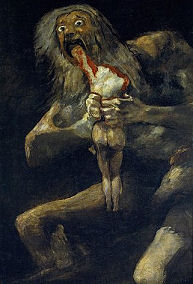
In ancient Greek mythology the father of Zeus is Chronos, represented by the planet Saturn. At one time chief of all the gods. At some point during his reign Chronos became aware of a prophecy that he would eventually be deposed by his children.
In order to prevent this he devoured each of them in turn the moment they were born; each birth being a conjunction of Saturn with his children i.e. the other planets. Zeus however escaped this fate, being hidden away from his father upon birth. Growing up in secret, he did ultimately fulfil the prophecy; deposing Chronos to take his place as the chief God.
Now another story wherein the word devour is employed to denote a conjunction concerns the attempt by Zeus to seduce the goddess Nemesis. So the story goes…
Zeus pursues Nemesis throughout the four seasons; she attempting to evade him by constantly changing her form. He finally catches up with her however upon the winter solstice, wherein he then devours her. Indeed, solstice markers are found to be times of great upheaval wherein conjunctions occur involving many celestial bodies.
Herein one may cite the words of Berossos, a notable Chaldean scholar from the fourth century BC:
Berossos, who interpreted the prophecies of Bel, attributes these disasters (the end of the world and its aftermath) to the movements of the planets. He is so certain of this that he can determine a date for the conflagration and the great flood. He maintains that the Earth will burn whenever all the planets, which now have different orbits, converge in cancer and are so arranged in the same path that a straight line can pass through their orbs, and that there will be a further great flood, when the same planets so converge in Capricorn. For under the sign of cancer occurs the change to summer, under Capricorn change to winter. They are signs of great power, occurring when there are movements in the change of season.
Seneca, “Naturales Questiones (questions about science)”
It is quite clear then from a consideration of the ancient myths that conjunctions do trigger great celestial upheaval, and indeed that the second part of Revelation 12, verse 4, is indicative of a conjunction of such power between the Sun (the red Dragon), the moon (the woman in childbirth) and the Earth (image below). The use of the word devour confirms this.

Following the conjunction and the birth of the child, who in fact is not consumed by the Dragon, but caught up to the throne of God instead, it is further noted that the woman goes ‘into the wilderness’ for safety, for a total of ‘a thousand two hundred and threescore days’ i.e. 1260 days.
Now this indeed is very interesting, as 1260 days returns the celestial pattern back to an almost exact 120° angular separation between the sun and moon – something that can be demonstrated with the most exacting values for both the Earth tropical year and the moon synodic month.
Tropical year = 365.2421897 days
Moon month = 29.5305891 days
US Naval Observatory and H. M. Nautical Almanac Office cited values.
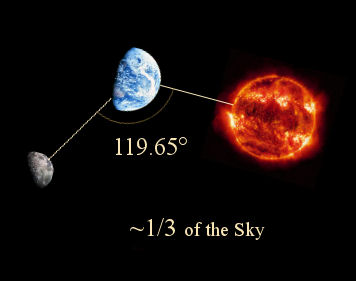
What happens then from an initial conjunction pattern, if one were to move forward in time 1260 days? What would the pattern be? Well, the moon synodic month is the time period between successive ‘top down’ conjunctions of all three bodies, therefore to understand where the moon is in its orbit relative to the Sun, one need only do a simple division sum: 1260 / 29.5305891 = 42.6676215.
Now in view of the answer, one should note that the numeric sequence of 0.666666… recurring is the basic fraction 2 / 3, and that following the decimal point the sequence as given is exceptionally close to this exacting fraction. What this means quite simply is that the moon has completed 42 full months, and is almost dead on two thirds of the way into its 43rd month.
There is therefore once more a third of the sky swept out from the moon through to the Sun, to complete the 43rd month (image above).
Revelation prophecy
Upon commencement of the 1260 day period a whole series of disasters strike the Earth, with also the emergence of a beast out of the sea and also a beast out of the Earth. For the most part the solution to many of these additional prophecies is to be had from a study of the heavens. Invariably they refer to exotic celestial phenomena, including conjunctions, ‘atmospheric flare-ups,’ and the destabilisation of the orbits of the planets within the solar system.
Next: The 7 Deadly Sins